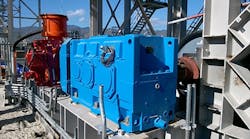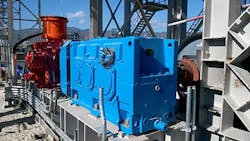High-speed belt conveyors have become very popular for many different bulk-material-handling systems. These conveyors are compact, efficient and high performance (Figure 1). In addition, raising the belt speed often offers a cost-effective way to increase the capacity of existing conveyors while keeping the loads and forces more or less similar on structures.
High-speed belt conveyors require precise calculations and simulations for many aspects of their engineering, particularly for belt tensions during different conditions such as steady, transient, dynamic and emergency. Additional stresses can occur, for instance, in the trough transition zones, on curves and elsewhere. The belts of high-speed conveyors are under increased tension and dynamic effects; their selection demands care as does their quality of manufacture.
So, in this article, we’ll consider the advantages and disadvantages of high-speed belt conveyors as well the particular challenges they pose. We’ll also look at two case studies.
Advantages
Many belt conveyors are low-speed types with belts running in the range of 2–4 m/s that transport materials a short distance, up to 1 km. In contrast, some critical services now rely on conveyors with belt speeds exceeding 5 m/s. Modern technologies enable achieving speeds as high as 10 m/s, 12 m/s or even more. The faster a belt runs, the more economic it is. This becomes especially significant for long-distance conveyors; such units should operate at the highest speeds possible. Long belt conveyors with higher speeds use narrower belt widths that are more compact and economical. However, higher speeds affect the engineering, selection, manufacturing, assembling and operation of parts and components.
Figure 1. A high-speed belt conveyor typically relies on an electric motor, gear box and coupling.
A major advantage of high-speed belt conveyors is reduced weight of material per unit length of the conveyor. This lower weight of material decreases the size and weight of load-bearing parts and components. Moreover, it exponentially reduces the sizing and weight of supporting structures. Such high-speed belt conveyors can use unusually lightweight, low cost and simple steel support structures — as well as longer spans between supports and columns. This results in compact and cost-effective units.
Lower linear weight decreases the belt tension necessary to control sag, indentation losses, and the tension required to lift the material. The reduced overall belt tension improves belt tracking on horizontal curves as well. The narrower belt is another benefit of the high speed; it needs a shorter idler roll length, which cuts the weight and cost of the idlers. Lower linear weight as well as narrow belts and shorter idlers also lead to overall better reliability.
Because many plants lack much available space, allocating land for a conveyor corridor can pose a challenge. So, the small footprint of high-speed conveyors is a great advantage that may enable revamp and renovation projects.
Belt Details
For longer high-speed conveyors with large capacity, dynamic analysis is extremely important. Analyzing the starting and stopping characteristics is essential. Belt speeds considerably higher than 5 m/s demand great care.
Fast belts with long center distances should have a high modulus of elasticity and low elongation values. When belts are under transient or emergency loading (such as when starting up, braking, etc.), additional stresses occur. These stresses can reach very high levels in some cases.
High-speed belts conveying large quantities of material over long distances must have high strength because, particularly during stopping/braking, tension is very high. So, such services often rely on steel cable belts.
Very-high-strength steel cable belts (say, with a breaking strength of 10,000 N/mm) theoretically are feasible but can pose many technical, reliability and operational problems. Realistically, the upper limit is around 8,000–8,500 N/mm. One reason is because the belts require steel cable tension members at least 14-mm thick and, thus, a drive pulley diameter of more than 2,000 mm. The thickness of belts exceeding that strength or cables of such diameter is at least 35–40 mm.
Therefore, the dead-load/working-load ratio rises substantially. Considering the weights of belt, pulleys and other components, the overall conveyor would be very heavy, expensive and bulky for a breaking strength exceeding 8,000–8,500 N/mm. In addition, the belt would have short part-lengths with many splices; this is undesirable because it reduces the troughability (the flexibility of the belt or its ability to match the trough).
Even belts with strengths of 8,000–8,500 N/mm present some challenges. They are difficult to manufacture and need highly accurate processing. To ensure the steel cables in the belt are parallel and to prevent them moving sideways during vulcanization, the cables must be pre-tensioned. This requires advanced manufacturing facilities capable of such high-quality production. Any irregularities in the manufacturing process, such as unequal cable pre-tensioning, can lead to mis-tracking and other operational problems.
Key Challenges
In general, higher speeds lead to greater wear and tear on belt conveyor components. The idler rolls and pulleys will rotate faster, the loading cycle of the belt will go up, and the turbulence of the bulk material at the loading and discharge points will increase. Moreover, high-speed operation shortens the life of the belt — mainly because most belt wear occurs in the loading zone and the belt sees the loading zone more often than a low speed belt does.
High-speed belt conveyors generally have long starting and stopping times. Their emergency stopping by braking generates a great amount of energy to be absorbed; this could cause more abnormalities, wear or even damage. Therefore, this aspect requires careful attention.
Higher speeds also induce more vibration and noise in the belt conveyor system. This has implications for engineering, operation and reliability. Allowable tolerances are substantially tighter for high-speed belt conveyor components than for their equivalent low-speed counterparts. In particular, to reduce vibration and noise and extend idler life, idler “total indicated runout” should not exceed 0.4 mm in the speed range of 6–9 m/s. Meeting such a tight tolerance is a great challenge. A welded-end disk idler assembly usually won’t suffice because the welding process warps the shell. So, fabrication may require advanced methods such as press-fit end disks, etc.
Minimizing vibration necessitates robust and rigid structures as well as tight structural tolerances. Alignment also is more challenging. As a rough indication, you should maintain the belt center-line to within ±1 mm. In many cases, the overall conveyor can’t accommodate training idlers. To avoid belt training issues, you usually should control the locations of the idlers to ±1 mm. Sometimes, even tighter tolerances are needed. This places increased importance on ensuring high-quality manufacturing and assembly because you don’t want to contend with idler adjustments during commissioning.
Two Case Studies
Let’s now consider a couple of applications of high-speed belt conveyors.
The first, part of a massive expansion project for an existing plant, is for a 7.3-m/s, elevated, horizontally curved belt conveyor to transport about 7,000 t/h of bulk material a relatively long distance in a processing unit. The route selected for the conveyor was tightly constrained by a number of existing facilities. The final configuration eliminated two transfer towers that were in the original feasibility study by using a tight, 1,200-m-radius horizontal curve.
The high-speed belt conveyor has a simple supporting structure that is far more cost-effective and lighter than those provided previously for comparable low-speed 7,000-t/h belt conveyors. The new conveyor gets power from two motors with variable-speed drives and includes two brakes. One brake is located on the tail pulley and the other within the take-up sheave assembly. The second brake serves to boost the take-up tension during an unpowered stop.
In the second case, a processing plant uses two high-speed belt conveyors for two different services. The first one has a speed of 7.6 m/s, a 2,800-mm width and a length of about 4 km. The power rating and capacity are 12 MW and 37,000 t/h, respectively. This conveyor features a steel cable belt of 5,000 N/mm. The second conveyor runs at 8.4 m/s, has a length of about 8 km, and a lift of approximately 800 m. It handles a maximum capacity of 2,400 t/h on a 1,300-mm-wide steel cable belt of 7,500 N/mm. The power rating is 10 MW.
AMIN ALMASI is a mechanical consultant based in Sydney, Australia. Email him at [email protected].



